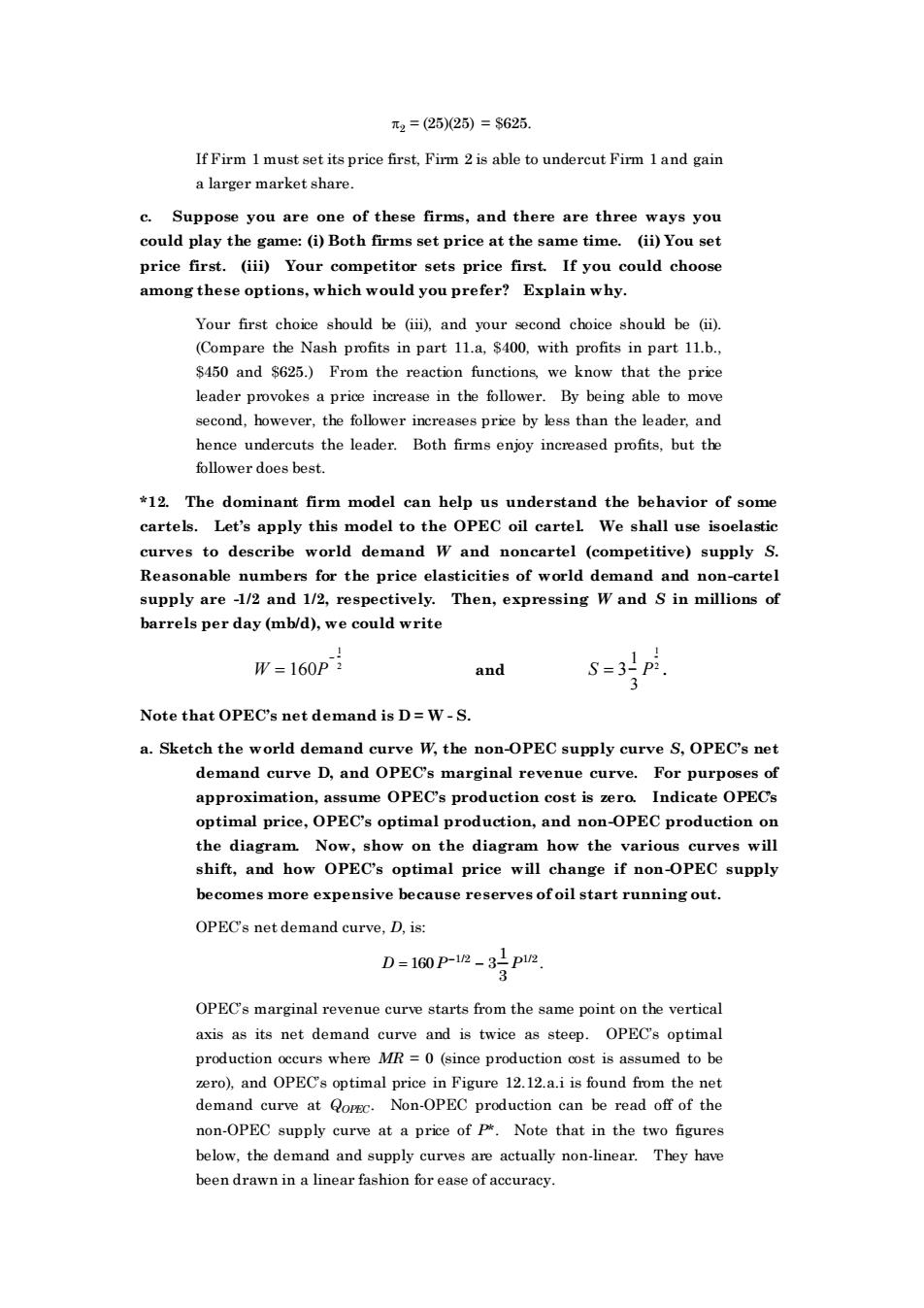正在加载图片...

m2=(25)25)=s625. If Firm 1 must set its price first,Firm 2is able to undercut Firm 1and gain a larger market share ays you price first.(iii)Your competitor sets price first.If you could choose among these options,which would you prefer?Explain why. Your first choice should be (iii)and your second choice should be fi) (Compare the Nash profits in part 11.a,$400,with profits in part 11.b. R450 and $625.)From the reaction functions we know that the prie leader provokes a pric increase in the follower. By being able to mov second,however,the follower increases price by less than the leader,and hence undercuts the leader.Both firms enjoy increased profits.but the follower does best. *12.The dominant firm model can help us understand the behavior of some cartels.Let's apply this model to the OPEC oil cartel We shall use isoelastic curves to world demand W and noncartel (competitive) supply S Reasonable numbers for the price elasticities of world demand and non-cartel supply are -1/2 and 1/2,respectively.Then,expressing W and S in millions of barrels per day (mb/d),we could write W=160P and S=31pi Note that OPEC's net demand is D=W-S. a.Sketch the world demand curve W,the non-OPEC supply curve S,OPEC's net demand curve D,and OPEC's s marginal revenue curve. For purpo approximation,assume OPEC's production cost is zero. Indicate OPECs optimal price,OPEC's optimal production,and non-OPEC production on the diagram.Now,show on the diagram how the various curves will shift,and how OPEC's optimal price will change if non-OPEC supply becomes more expensive because reserves ofoil start running out. OPECs net demand curve,D,is: D=160P-i-32p OPEC's marginal revenue curve starts from the same point on the vertical axis as its net demand curve and is twice as steep.OPEC's optimal and OPEC's optimal price i e 12.12.a.i is found from urve at Qorc. on can be non-OPEC supply curve at a price of p.Note that in the two figures below,the demand and supply curves are actually non-linear.They have been drawn in a linear fashion for ease of accuracy. 2 = (25)(25) = $625. If Firm 1 must set its price first, Firm 2 is able to undercut Firm 1 and gain a larger market share. c. Suppose you are one of these firms, and there are three ways you could play the game: (i) Both firms set price at the same time. (ii) You set price first. (iii) Your competitor sets price first. If you could choose among these options, which would you prefer? Explain why. Your first choice should be (iii), and your second choice should be (ii). (Compare the Nash profits in part 11.a, $400, with profits in part 11.b., $450 and $625.) From the reaction functions, we know that the price leader provokes a price increase in the follower. By being able to move second, however, the follower increases price by less than the leader, and hence undercuts the leader. Both firms enjoy increased profits, but the follower does best. *12. The dominant firm model can help us understand the behavior of some cartels. Let’s apply this model to the OPEC oil cartel. We shall use isoelastic curves to describe world demand W and noncartel (competitive) supply S. Reasonable numbers for the price elasticities of world demand and non-cartel supply are -1/2 and 1/2, respectively. Then, expressing W and S in millions of barrels per day (mb/d), we could write W = 160P − 1 2 and S = 3 1 3 P 1 2 . Note that OPEC’s net demand is D = W - S. a. Sketch the world demand curve W, the non-OPEC supply curve S, OPEC’s net demand curve D, and OPEC’s marginal revenue curve. For purposes of approximation, assume OPEC’s production cost is zero. Indicate OPEC’s optimal price, OPEC’s optimal production, and non-OPEC production on the diagram. Now, show on the diagram how the various curves will shift, and how OPEC’s optimal price will change if non-OPEC supply becomes more expensive because reserves of oil start running out. OPEC’s net demand curve, D, is: D = P − P − 160 3 1 3 1/2 1/2 . OPEC’s marginal revenue curve starts from the same point on the vertical axis as its net demand curve and is twice as steep. OPEC’s optimal production occurs where MR = 0 (since production cost is assumed to be zero), and OPEC’s optimal price in Figure 12.12.a.i is found from the net demand curve at QOPEC. Non-OPEC production can be read off of the non-OPEC supply curve at a price of P*. Note that in the two figures below, the demand and supply curves are actually non-linear. They have been drawn in a linear fashion for ease of accuracy